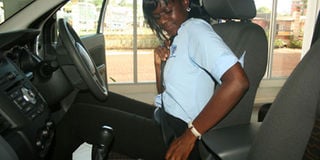Make seatbelts a priority

Before anything else, automotive manufacturers always put safety first on the back of their minds.
As a driver and passengers alike you are expected to buckle up your seatbelt or safety belt every time you hit the road.
You are also expected to at all times ensure the safety of other road users by using turn signals such as indicators every time you connect to a new road or make a stop.
Therefore, it is unfortunate to see that in Uganda basic safety measures are ignored.
Seatbelts, which should be second nature for any motorists, are regarded as a burden or are simply ignored and only gain meaning where there is a traffic officer.
Safety, given the nature of many Ugandan roads that are riddled with potholes and dangerous bends, should be a priority.
Data regarding many road accidents in Uganda points to reluctance of motorists to consider safety as a priority.
At least, you have heard of stories of how only one person survives an accident in a four-seater car because they were buckled up.
At some point government had made seatbelts a mandatory safety feature for every car including public transport cars such as taxis and buses.
However, this was just enforced for a short period of time. Since then many Ugandans have forgotten about this safety feature.
Highway driving, especially on accident prone roads such Masaka – Mbarara Road and Jinja Road should be well supervised by traffic police to enforce the use of safety features.
However, the irony is for traffic police officers, who are supposed to enforce the law, is ensuring that motorists, are lured into traps so that they can be apprehended.
For instance, at the traffic lights on Jinja Road, many police officers will cunningly wait to see who has driven through the red-lights, before they engage in a chase game.
Such police officers are in most cases only interested in exhorting from motorists and not enforcing safety.
“If you let drivers commit offences simply because you want to trap them then it becomes questionable. This is why many motorists ignore traffic rules and only follow them if they see a traffic officer nearby,” says Ali Kinene, a motorist.
On several occasions, he says, it defeats his understanding if traffic officers are after enforcing the law.
“Seatbelts should be a priority to all motorists and should be enforced by traffic police as they have the potential to cut back on death in case of an accident,” says Kinene.
If a car had to suddenly stop or crushed into something the impact is usually unimaginable and can potentially throw out its occupants.
This is when the concept of the seatbelt comes into play as it has the capacity to slow or reduce the impact of an accident by 17 per cent.
A seatbelt is made with different pressure and adjustable points. Therefore, it has the potential to slow or stop a person’s movement in case of a sudden stop.
At just 40 kilometres per hour, the car has gained enough speed to force its occupants out through the front windscreen.
The force with which the occupants move is enough to shatter the front windscreen before they are thrown out in different directions.
Other safety features
Safety is increasingly becoming a requirement for many car manufactures.
Other features such airbags, electronic stability control, traction control and adjustable steering column, among others, have become fixtures for every car.
Other safety features include blind spot warning system, daytime running lights, fog lamps, head restraints, pre-crash safety system, reversing camera and tyre pressure monitor.
However, all these seatbelts are the oldest innovations. Seatbelts cut back by 17 per cent the chances of someone getting injured or killed in case of a fatal accident.




